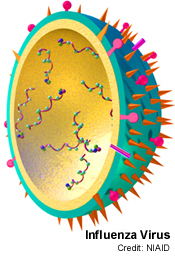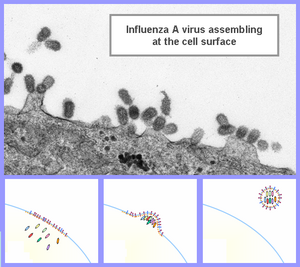Influenza - Flu Facts
Ed Hutchinson, Cambridge UniversityWe’re talking about infectious diseases and foremost among them the thing which surprises most people actually kills about twelve thousand people every single year and that’s influenza. Ed Hutchinson’s a researcher from Cambridge University, so Ed, what is this beast that we all succumb to on a regular basis?
 Ed - Well, for starters it’s a virus and like all viruses it’s incredibly small: 100nm across. That’s about a quarter of the wavelength of visible light. Because it’s so small it can replicate incredibly quickly but also because it’s so small it really can’t do anything. It really has to take over cells and get them to do all the jobs it needs.
Ed - Well, for starters it’s a virus and like all viruses it’s incredibly small: 100nm across. That’s about a quarter of the wavelength of visible light. Because it’s so small it can replicate incredibly quickly but also because it’s so small it really can’t do anything. It really has to take over cells and get them to do all the jobs it needs. Chris - So you mean, because the virus is so tiny it doesn’t have the machinery to copy itself so it needs to invade us, or things like us, to do that?
Ed - Exactly, it’s traded off that ability in order to replicate very quickly.
Chris - Is it just us that get the flu?
Ed - No, it comes in several different types. The one we really worry about we call Influenza A and that infects a huge range of different creatures. It infects people but it also infects birds, we worry a lot about bird flu. It infects seals, it infect whales.
Chris - If you could see the flu what would the virus look like?
Ed - It looks a bit like a kidney bean really, or a baked bean floating around. It’s this little oval thing. You would need a very powerful microscope, you’d need an electron microscope because it’s far smaller than the wavelength of [visible] light. That’s most viruses. Now some of the influenza viruses as well, stay the same width but extend out great, long filaments. The ones we spend most of our time studying are little baked bean-shaped things.
Chris - Why do they form these filaments?
Ed - That’s not really very well understood. We know this happens in clinical isolates. It doesn’t tend to have them when you’re looking at them in the lab. But when they’re growing in your throat sometimes these viruses grow out these big strands which extend upwards into the mucous which is covering the cells in your throat. We think it might have something to do with getting the virus coughed out and spread on from person to person. The way this virus spreads is that it gets into the mucous. You cough or you sneeze and if a handkerchief doesn’t get in the way it then gets breathed in by someone else and they get infected.
Chris - Are handkerchiefs actually useful as a way of stopping it because it sounds like it’s so tiny that a handkerchief which you can physically see through if you hold it up to the light, it doesn’t seem like much of a barrier.
Ed - Yeah, but bear in mind you’re not just coughing up a virus, you’re coughing up a whole ball of snot as well so it is going to stick in your handkerchief.
Chris - I should point out at this point there’s a wonderful article on our website this eek. It’s been written by Becky Poole and it’s all about why snot is green. If you go to thenakedscientists.com you’ll see it’s advertised there: all about the science of mucous to give it it’s proper name. But Ed, carrying on with your guided tour of flu, what are the key points about it?
Ed - What you’ve got is really a box which has got the flu genes on the inside. On the outside it’s got some proteins, the thing the virus is built of. These allow it to get in to cells and to get out again. These proteins grab on to cells and the virus gets inside. Within about 12 hours it’s copied itself hundreds and hundreds of times. It’s incredibly quick. Like I said, very small, very quick replication.
Chris - The incubation period of flu is incredibly short. When you think that most air travel for example, can bring you to the other side of the world and it takes 24 hours to do it. If you picked up flu on one side of te planet you could be infectious for it during touchdown.
Ed - It’s a scary thought when you put it like that, yes.
Chris - How does it get into the cells that it needs to invade and then how does it take them over?
Ed - On the outside of the flu it’s decorated with a little stalk called hemagglutinin. Now we tend to abbreviate that to HA or even H. That grabs onto the surface of the cell and pulls the virus inside. Once the virus is inside that box that holds the genes inside it opens up. The virus genes fall out into the centre of the cell. Then they just take the cell over and turn it into a factory for making more flu. When the virus gets out again as it assembles it uses another protein that decorates the outside of the virus called neuraminidase which we abbreviate to NA or N. That cuts it off from the cell and gets it out again. The reason I’m mentioning the hemagglutinin (the HA) and the neuraminidase (the NA) is because these cover the outside of viruses, they are protein building blocks recognised by the immune system. It’s these things which antibodies stick to. It I for this reason when we talk about viruses we tend to categorise them by their hemagglutinin type and their neuraminidase type – their H type and their N type.
Chris - Like H5N1?
Ed - Exactly.
Chris - When this genetic virus goes in what’s the genetic material it uses because people talk about the flu continuously coming back? If it was just the same infection every time people would be getting immune to it but we don’t. Why is that?
 Ed - Flu mutates very, very rapidly. This is partly because it’s genome, instead of being built of DNA (that’s what we use), it’s built of RNA. That’s if you like a far more primitive thing to build a genome out of and is absolutely hopeless at copying so rapidly so flu is constantly mutating all the time. Because of this the vaccine which we use against flu needs to be constantly updated. There’s another side to this as well. Every so often, we’re talking a few times a century, flu will suddenly change. The H type and the N type will change to something completely different. That can be catastrophic. This is a disease which normally will kill 250-500 million people globally every year.
Ed - Flu mutates very, very rapidly. This is partly because it’s genome, instead of being built of DNA (that’s what we use), it’s built of RNA. That’s if you like a far more primitive thing to build a genome out of and is absolutely hopeless at copying so rapidly so flu is constantly mutating all the time. Because of this the vaccine which we use against flu needs to be constantly updated. There’s another side to this as well. Every so often, we’re talking a few times a century, flu will suddenly change. The H type and the N type will change to something completely different. That can be catastrophic. This is a disease which normally will kill 250-500 million people globally every year. Chris - What you’re talking about is a new pandemic. You get an epidemic which gently changes and turns into something that is devastatingly different.
Ed - Yes, exactly. These completely new viruses will sweep through the population.
January 2008sumber tulisan: (http://www.thenakedscientists.com/HTML/content/interviews/interview/859/)
Tidak ada komentar:
Posting Komentar